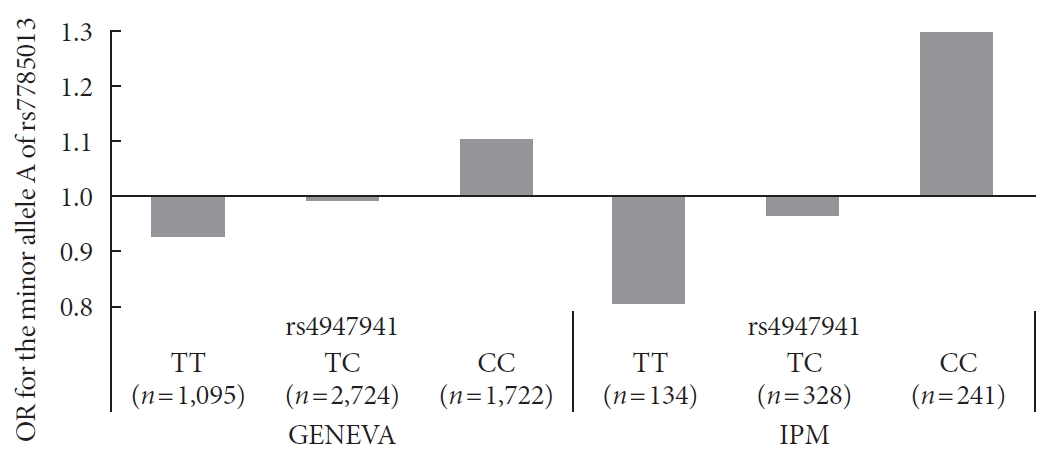
- Current
- Browse
- Collections
-
For contributors
- For Authors
- Instructions to authors
- Article processing charge
- e-submission
- For Reviewers
- Instructions for reviewers
- How to become a reviewer
- Best reviewers
- For Readers
- Readership
- Subscription
- Permission guidelines
- About
- Editorial policy
Search
- Page Path
- HOME > Search
- Genetics
- Enhancer-Gene Interaction Analyses Identified the Epidermal Growth Factor Receptor as a Susceptibility Gene for Type 2 Diabetes Mellitus
- Yang Yang, Shi Yao, Jing-Miao Ding, Wei Chen, Yan Guo
- Diabetes Metab J. 2021;45(2):241-250. Published online June 10, 2020
- DOI: https://doi.org/10.4093/dmj.2019.0204

- 6,042 View
- 104 Download
- 3 Web of Science
- 4 Crossref
-
 Abstract
Abstract
 PDF
PDF Supplementary Material
Supplementary Material PubReader
PubReader  ePub
ePub Background Genetic interactions are known to play an important role in the missing heritability problem for type 2 diabetes mellitus (T2DM). Interactions between enhancers and their target genes play important roles in gene regulation and disease pathogenesis. In the present study, we aimed to identify genetic interactions between enhancers and their target genes associated with T2DM.
Methods We performed genetic interaction analyses of enhancers and protein-coding genes for T2DM in 2,696 T2DM patients and 3,548 controls of European ancestry. A linear regression model was used to identify single nucleotide polymorphism (SNP) pairs that could affect the expression of the protein-coding genes. Differential expression analyses were used to identify differentially expressed susceptibility genes in diabetic and nondiabetic subjects.
Results We identified one SNP pair, rs4947941×rs7785013, significantly associated with T2DM (combined
P =4.84×10−10). The SNP rs4947941 was annotated as an enhancer, and rs7785013 was located in the epidermal growth factor receptor (EGFR ) gene. This SNP pair was significantly associated withEGFR expression in the pancreas (P =0.033), and the minor allele “A” of rs7785013 decreasedEGFR gene expression and the risk of T2DM with an increase in the dosage of “T” of rs4947941.EGFR expression was significantly upregulated in T2DM patients, which was consistent with the effect of rs4947941×rs7785013 on T2DM andEGFR expression. A functional validation study using the Mouse Genome Informatics (MGI) database showed thatEGFR was associated with diabetes-relevant phenotypes.Conclusion Genetic interaction analyses of enhancers and protein-coding genes suggested that
EGFR may be a novel susceptibility gene for T2DM.-
Citations
Citations to this article as recorded by- Genome-Wide Epistasis Study of Cerebrospinal Fluid Hyperphosphorylated Tau in ADNI Cohort
Dandan Chen, Jin Li, Hongwei Liu, Xiaolong Liu, Chenghao Zhang, Haoran Luo, Yiming Wei, Yang Xi, Hong Liang, Qiushi Zhang
Genes.2023; 14(7): 1322. CrossRef - Investigation of the mechanism of Shen Qi Wan prescription in the treatment of T2DM via network pharmacology and molecular docking
Piaopiao Zhao, Xiaoxiao Zhang, Yuning Gong, Weihua Li, Zengrui Wu, Yun Tang, Guixia Liu
In Silico Pharmacology.2022;[Epub] CrossRef - The Role of the Epidermal Growth Factor Receptor in Diabetic Kidney Disease
Raymond C. Harris
Cells.2022; 11(21): 3416. CrossRef - Co-expression Network Revealed Roles of RNA m6A Methylation in Human β-Cell of Type 2 Diabetes Mellitus
Cong Chen, Qing Xiang, Weilin Liu, Shengxiang Liang, Minguang Yang, Jing Tao
Frontiers in Cell and Developmental Biology.2021;[Epub] CrossRef
- Genome-Wide Epistasis Study of Cerebrospinal Fluid Hyperphosphorylated Tau in ADNI Cohort

 KDA
KDA
 First
First Prev
Prev





